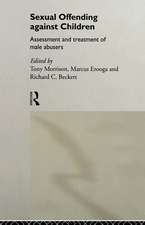Gendertrolling: How Misogyny Went Viral
Autor Karla Mantillaen Limba Engleză Hardback – 30 aug 2015 – vârsta până la 17 ani
Preț: 357.89 lei
Preț vechi: 416.36 lei
-14% Nou
Puncte Express: 537
Preț estimativ în valută:
68.50€ • 74.44$ • 57.58£
68.50€ • 74.44$ • 57.58£
Carte tipărită la comandă
Livrare economică 21 aprilie-05 mai
Preluare comenzi: 021 569.72.76
Specificații
ISBN-13: 9781440833175
ISBN-10: 1440833176
Pagini: 280
Dimensiuni: 156 x 235 x 25 mm
Greutate: 0.61 kg
Editura: Bloomsbury Publishing
Colecția Praeger
Locul publicării:New York, United States
ISBN-10: 1440833176
Pagini: 280
Dimensiuni: 156 x 235 x 25 mm
Greutate: 0.61 kg
Editura: Bloomsbury Publishing
Colecția Praeger
Locul publicării:New York, United States
Caracteristici
Demonstrates what online rape and death threats have in common with street harassment, sexual harassment in the workplace, domestic violence, and date rape, showing the serious, harmful nature of this practice
Notă biografică
Karla Mantilla is managing editor at Feminist Studies, an interdisciplinary women's studies journal.
Cuprins
AcknowledgmentsPART I: GENDERTROLLING AND ITS EFFECTSChapter 1: IntroductionChapter 2: Characteristics of GendertrollingChapter 3: Responses to Gendertrolling CampaignsChapter 4: Fighting BackPART II: GENDERTROLLING IN HISTORICAL AND SOCIAL CONTEXTChapter 5: Gendertrolling: It's Not about the InternetChapter 6: The Power of NamingChapter 7: Cultural Defense Mechanisms as BacklashChapter 8: Gendertrolling: Cultural Defense Mechanisms at WorkChapter 9: Recommendations for ChangeEpilogueNotesIndex
Recenzii
Mantilla's work is valuable . . . for gathering firsthand voices of gendertrolling victims about their experiences, reactions, and attempts to fight back. Furthermore, the author successfully contextualizes gendertrolling in the history of misogyny. By doing so, she persuasively argues that gendertrolling is not unique to digital experiences but is a new form of misogyny and abuse against women. She lists various recommendations for legal protections and strategies to fight against gendertrolling and generate solutions. Summing Up: Recommended. All levels/libraries.
The contemporary issues addressed in the book are relevant to undergraduate and graduate instructors seeking to offer guidance in new media, prejudice, and the ethics of unrestricted 'free speech' in Internet environments. Each chapter can be taught independently, allowing for text-based questions and discussion in a small graduate-level seminar or a large undergraduate lecture. . . . Mantilla's book has utility beyond the classroom settingbecause it contributes to a larger cultural conversation concerning the regulation of online sexist speech.
The contemporary issues addressed in the book are relevant to undergraduate and graduate instructors seeking to offer guidance in new media, prejudice, and the ethics of unrestricted 'free speech' in Internet environments. Each chapter can be taught independently, allowing for text-based questions and discussion in a small graduate-level seminar or a large undergraduate lecture. . . . Mantilla's book has utility beyond the classroom settingbecause it contributes to a larger cultural conversation concerning the regulation of online sexist speech.











